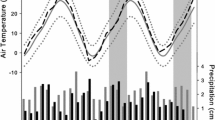Abstract.
C4 plants are uncommon in cold environments and do not generally occur in the alpine tundra. In the White Mountains of California, however, the C4 grass Muhlenbergia richardsonis is common in the alpine zone at 3,300–3,800 m, with the highest population observed at 3,960 m (13,000 feet) above sea level. This is the highest reported C4 species in North America and is near the world altitude limit for C4 plants (4,000–4,500 m). Above 3,800 m, M. richardsonis is largely restricted to southern slope aspects, with greatest frequency on southeast-facing slopes. In open tundra, M. richardsonis formed prostrate mats with a mean height of 2.5 cm. Neighboring C3 grasses were two to three times taller. Because of its short stature, leaf temperature of M. richardsonis was greatly influenced by the boundary layer of the ground, rising over 20°C above air temperature in full sun and still air and over 10°C above air temperature in full sun and wind velocity of 1–4 m s–1. Thus, although air temperatures did not exceed 15°C, midday leaf temperatures of M. richardsonis were routinely between 25°C and 35°C, a range favorable to C4 photosynthesis. At night, leaf temperature of M. richardsonis was often 5–12°C below air temperature, resulting in regular exposure to subzero temperatures and frosting of the leaves. No visible injury was associated with exposure to freezing night temperatures. The presence of M. richardsonis in the alpine zone demonstrates that C4 plants can tolerate extreme cold during the growing season. The localization to microsites where leaf temperatures can exceed 25°C during the day, however, indicates that even when cold tolerant, C4 plants still require periods of high leaf temperature to remain competitive with C3 species. In this regard, the prostrate growth form of M. richardsonis compensates for the alpine climate by allowing sufficient heating of the leaf canopy during the day.
Similar content being viewed by others
Author information
Authors and Affiliations
Corresponding author
Additional information
Electronic Publication
Rights and permissions
About this article
Cite this article
Sage, R.F., Sage, T.L. Microsite characteristics of Muhlenbergia richardsonis (Trin.) Rydb., an alpine C4 grass from the White Mountains, California. Oecologia 132, 501–508 (2002). https://doi.org/10.1007/s00442-002-0959-8
Received:
Accepted:
Published:
Issue Date:
DOI: https://doi.org/10.1007/s00442-002-0959-8




